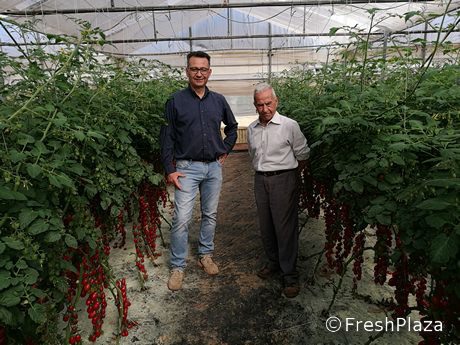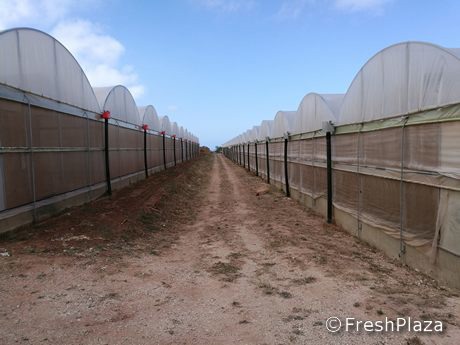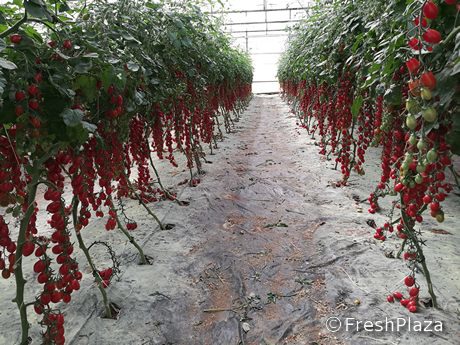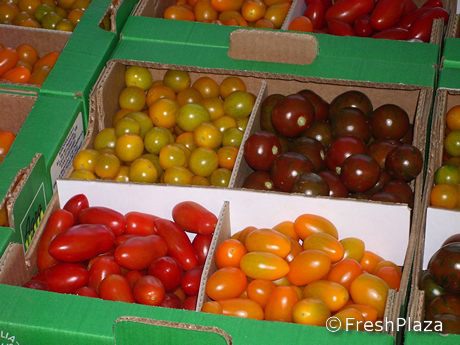"We have been growing organically since 2004 and back then we were a rarity in the area around Vittoria, in Sicily. We have been certified by the BioAgriCert already for a while and, despite being a small-medium company, we are able to defend our revenue". Thus says Salvatore Modica, whose homonymous farm covers 3.6 hectares of land.
 Salvatore and Mario Modica
Salvatore and Mario Modica
Modica: "2.4 hectares of our land are dedicated to greenhouses, and our choices, as for other companies that work with organic farming, are always taken carefully to avoid the risk of compromising the products. Among these choices, there is the maintenance of soil fertility through a well-humidified organic substance, soil solarization, the choice of the varieties to cultivate according to their genetic resistance and the use of the rootstock suitable for the cultivation needs".
 External overview of the greenhouses
External overview of the greenhouses
Even nutrition management must be very careful because a plant in excellent nutritional status is better protected from adversity. Another determining factor is the use of natural allies that can help us to fight harmful insects. Fortunately, a good professional has been counselling us: his support has been crucial for us, despite my father having decades-long experience in this field".

Nature, in itself, is a balanced system that follows its own rhythms. On the contrary, a greenhouse is a complex system where natural balance is altered by the intensification of the farming processes. In order to restore the biological balance, it is necessary to make specific agricultural choices.
 Above: Cikito tomato, Summer sun (yellow cherry tomato), Santorange (Yellow-orange Cikito tomato), Caprese (Mini Sanmarzano), Sissy (Brown tomato) and Zebrino (with dark green stripes). Unfortunately, some varieties can be seen only partially in this photo.
Above: Cikito tomato, Summer sun (yellow cherry tomato), Santorange (Yellow-orange Cikito tomato), Caprese (Mini Sanmarzano), Sissy (Brown tomato) and Zebrino (with dark green stripes). Unfortunately, some varieties can be seen only partially in this photo.
Modica: "As far as our company is concerned, the decisions are made thanks to the continuous exchange of information between farmers and technicians. The latter must be able to provide indications for the management of any problems in the shortest possible time, often relying only on their own experience. Despite the great commitment it requires, we believe that the organic sector is destined to be increasingly appreciated by final consumers anyway.
Production
The main vegetables produced by the company are cucumber (45 tons), Cikito tomato (44 tons), tomato on the vine (30 tons), coloured tomato (27 tons), pepper (24 tons) and zucchini (7 tons),
Over the years, in addition to the products mentioned above, the company has also started to grow cherry tomatoes, specializing in coloured species. In Northern Europe, this market has already been successful for many years, whereas in Italy it has been appreciated for a relatively short time. Since this year, also a small cultivation of zucchini has been introduced. This production is "destined to grow, as far as it is compatible with the company needs".
With regard to the destination markets, around 30% is represented by Italy, and 70% by Europe, especially Germany and France.
Contact details:
Azienda Agricola Modica
C.da Piano Savia
97019 Vittoria (RG) - Italy
Phone: +39 333 4161078
